Key takeaways:
- Natural light enhances mood, well-being, and productivity while being a sustainable solution for illuminating spaces.
- Maximizing natural light involves strategic placement of furniture, using reflective surfaces, and choosing lighter colors and materials.
- Flexibility in utilizing natural light throughout the day can significantly improve atmosphere and adaptability to changing conditions.
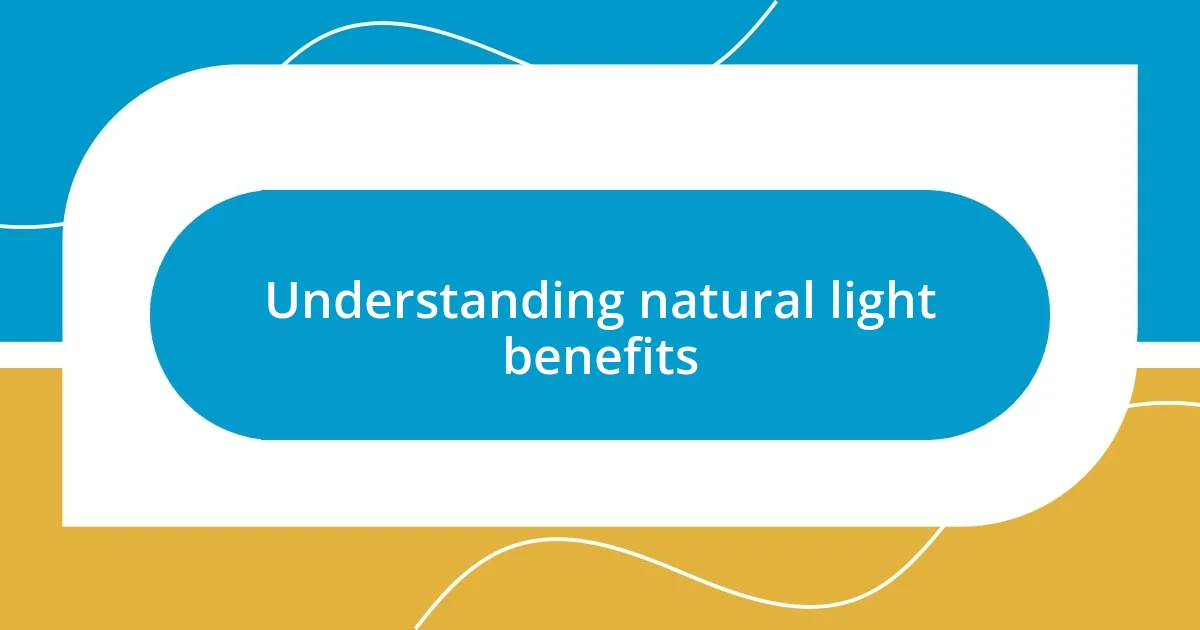
Understanding natural light benefits
Natural light has an incredible way of transforming a space, making it feel more open and inviting. I remember when I moved into my current apartment; the large windows filled the room with soft, golden light each morning. It felt like a gentle nudge to start my day, and I instantly noticed how much it uplifted my mood.
Another benefit of natural light is that it’s free and sustainable, providing a cost-effective way to brighten your life and home. Have you ever considered how much energy you save by relying on sunlight during the day? I made a conscious effort to arrange my workspace by the window, and not only did it cut down on my electricity bill, but I found that my productivity soared. It’s as if the sun itself became my coworker, cheering me on while I tackled projects.
Moreover, exposure to natural light can enhance your well-being. I’ve experienced firsthand how a lack of sunlight can affect my energy levels, often leading to that mid-afternoon slump. By positioning my favorite reading nook beside a window, I’ve created a cozy haven that boosts my spirits and keeps me engaged. Have you thought about how natural light can improve your own daily routines? It’s amazing what a little sunlight can do for both your physical and mental health.

Identifying ideal natural light sources
When identifying ideal natural light sources, I often find that the size and orientation of windows play a crucial role. I recall decorating my living room, where the south-facing windows allowed sunlight to stream in throughout the day. The difference it made in warmth and ambiance was remarkable, creating a cheerful space where I loved spending time with friends.
Beyond size, the type of surrounding structures can significantly impact how light enters a room. For instance, in my previous apartment, I had a delightful east-facing kitchen nook. Here, I enjoyed breakfast bathed in the gentle morning light. It transformed a mundane routine into a ritual that filled me with energy for a productive day. In short, I realized that not all light sources are created equal—there’s a lot to consider for maximizing the impact of natural light.
Another factor I’ve noticed is the color and material of interior walls. Lighter surfaces reflect natural light better, making a space feel larger. I once painted my home office in a soft, pale blue. The way it bounced sunlight around the room exceeded my expectations, creating a calming environment that boosted my creativity. Simple adjustments can make your home not just brighter, but also more nurturing when it comes to light flow.
| Criteria | Considerations |
|---|---|
| Window Size | Larger windows let in more light |
| Window Orientation | South-facing typically offers best light |
| Surrounding Structures | Nearby buildings/trees may block light |
| Wall Color | Lighter walls reflect and amplify light |

Maximizing window light usage
To truly maximize window light usage, I’ve found that strategic placement of furniture can make a significant difference. In my own experience, moving my desk closer to the window not only flooded my workspace with daylight but also completely altered my mood while working. It was like turning on a mental switch; suddenly, I felt more awake and engaged, as if the sunlight was inspiring my creativity.
Here are some practical tips for making the most of your window light:
- Identify hotspots: Place your favorite seating or workspace in areas where natural light is most abundant.
- Avoid blocking windows: Keep curtains and blinds open during the day, and resist the urge to clutter near the window.
- Use mirrors strategically: I’ve hung a mirror opposite my window to reflect light deeper into the room, instantly brightening up corners that felt a bit dull.
- Select light-colored furnishings: Lighter fabrics and surfaces enhance the overall brightness and create a more airy atmosphere.
In another home, I chose to install sheer drapes instead of heavy curtains. This simple change transformed the way sunlight filtered through, creating a soft, diffused glow that felt both calming and inviting. I often found myself pausing to enjoy the way light danced on my walls, reaffirming how essential it is to allow as much natural light in as possible.
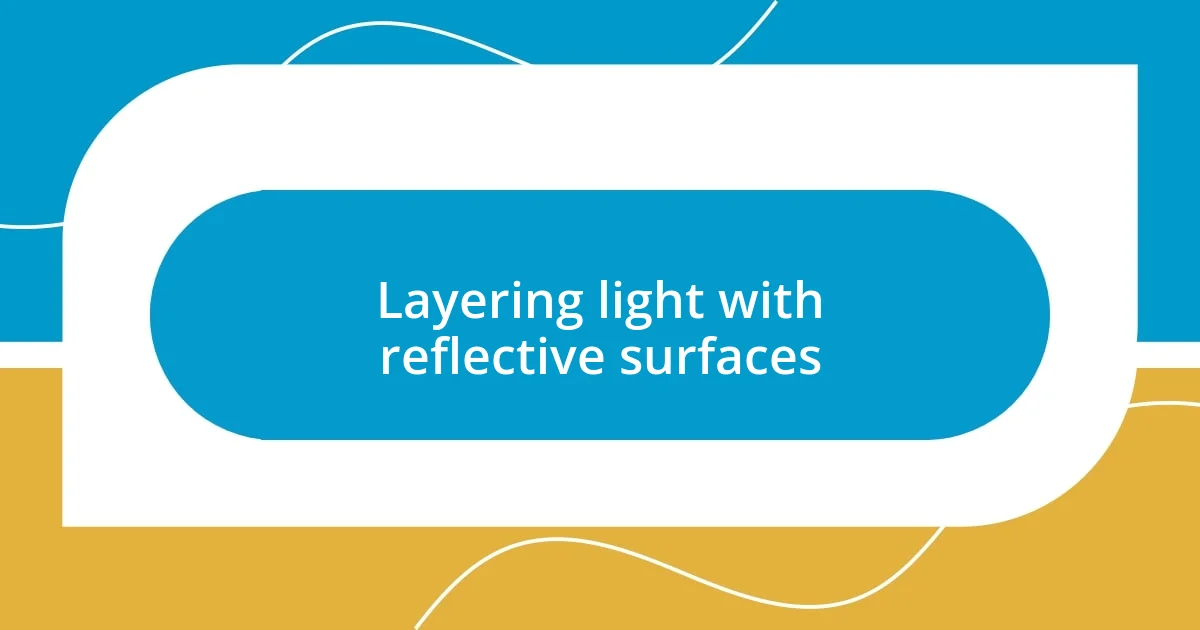
Layering light with reflective surfaces
In my quest to layer light effectively, I’ve discovered the magic of using reflective surfaces throughout my home. I once placed a shiny metal vase on my kitchen counter, simply to enhance the decor. What surprised me was how the sunlight bounced off it, amplifying the brightness and spreading that wonderful glow throughout the entire room. It’s like I had an additional window; have you ever experienced a small change making such a big difference?
Mirrors have become my go-to tool for creating depth in spaces lacking natural light. I vividly remember how I positioned a large mirror along a hallway that previously felt dark and narrow. Suddenly, that passage turned into a bright, airy corridor that beckoned me to walk its length. The illusion of space was unbelievable; it’s fascinating how the right reflective surface can change not just light, but the overall perception of a room.
I also pay attention to light-colored furniture, especially in smaller areas. A light-colored side table I chose for my living room seemed almost unassuming, yet it plays a vital role in reflecting natural light. This not only enhances the ambiance but also makes the area feel more open and inviting. Where do you find opportunities to incorporate reflective elements in your own space? Exploring these options can lead to delightful surprises in how light transforms your environment.
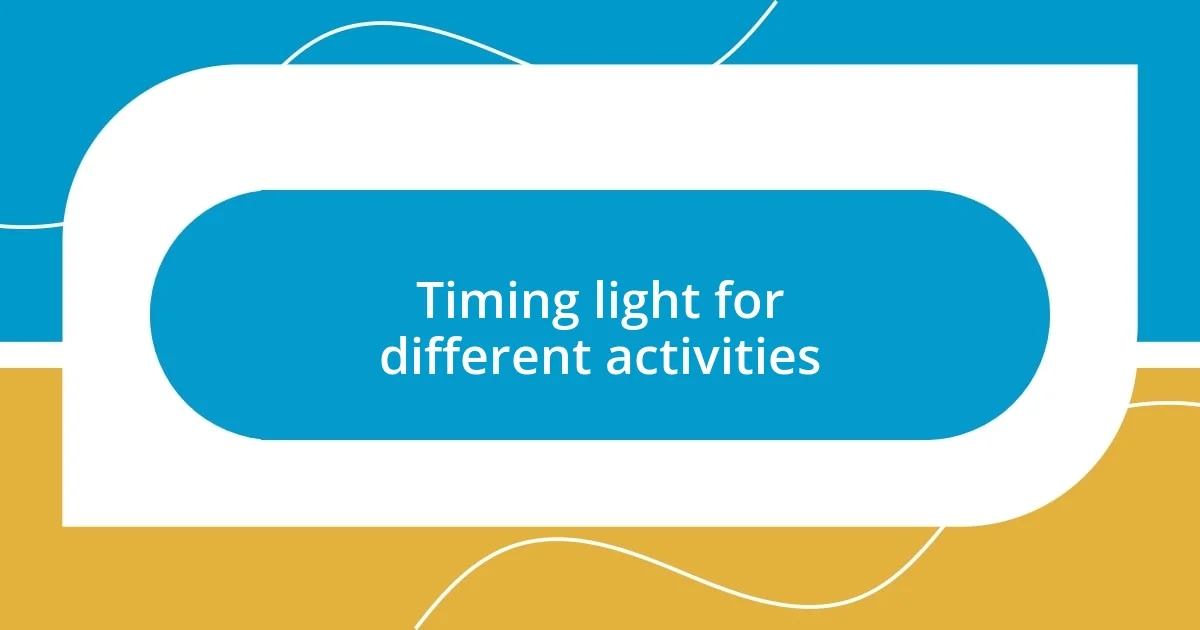
Timing light for different activities
When it comes to timing light for different activities, I’ve learned that the position of the sun can greatly influence my mood and productivity. For instance, early mornings are perfect for focused work. The soft, diffused glow of sunrise can be incredibly energizing, creating an atmosphere that feels fresh and inspiring. Have you ever noticed how a warm morning light can make even mundane tasks feel more enjoyable?
Midday, I switch gears to embrace the vibrant, direct sunlight pouring through my windows. This is when I tackle more creative projects or engage in brainstorming sessions. I recall working on a painting during a sunlit afternoon when the room was alive with color and warmth. It felt as if the sunlight was infusing my canvas with energy, pushing me to explore new ideas and techniques. Doesn’t it amaze you how different lighting can trigger various creative energies?
As the day winds down, I often transition to softer light for relaxing activities. I dim the lights or draw the curtains to create a cozy environment, perfect for reading or unwinding. I distinctly remember an evening spent curling up on my sofa with a good book, illuminated by the gentle glow of lamplight. It was a delightful way to embrace the calming transition from day to night, reminding me of the importance of adjusting my light to suit my activities. How do you harness natural light to fit your evening routine?
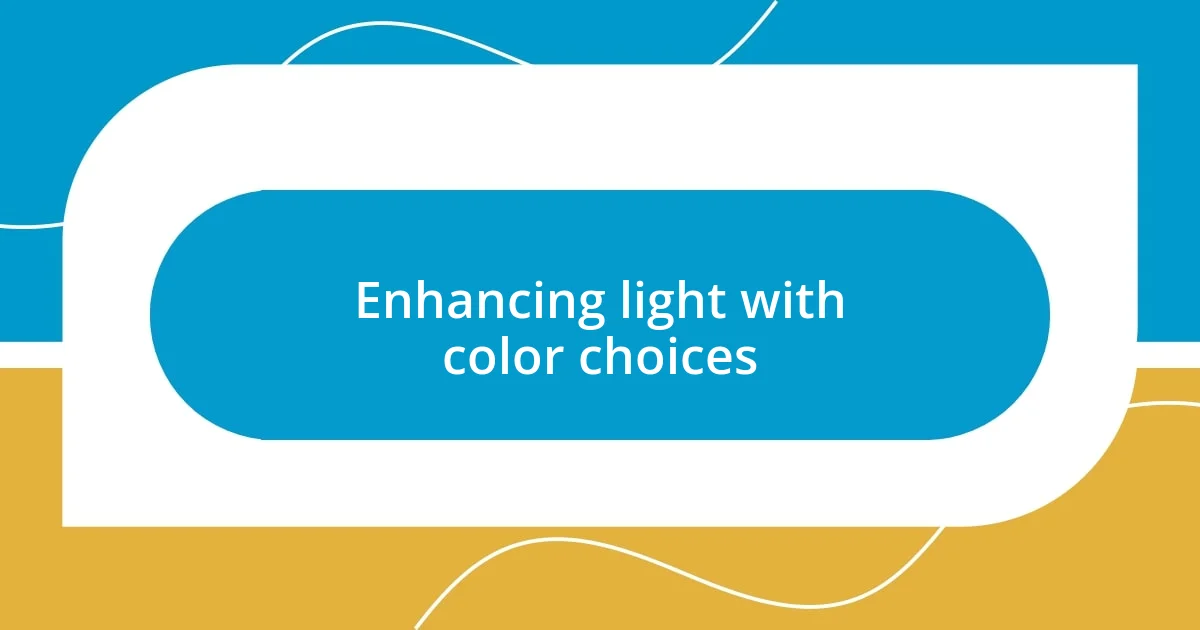
Enhancing light with color choices
Choosing the right colors in your space can dramatically enhance how natural light interacts with your surroundings. For example, when I painted my bedroom walls a soft, light blue, it did wonders for reflecting light. I remember waking up to a room bathed in a gentle glow that felt both calming and invigorating. Have you ever noticed how color can transform your experience of light?
I’ve also found that incorporating warmer tones can create a cozy atmosphere, especially in larger spaces. In my living room, I opted for earthy accents like terracotta and muted yellows. When the afternoon sun filters through the windows, these colors seem to absorb the light, casting a warm, inviting tone throughout the area. It’s a reminder of how thoughtful color choices can play a huge role in making a space feel welcoming. What colors resonate with you in your own environment?
Interestingly, I believe that contrasts can also enhance how light feels in a room. In my office, I paired bright white walls with darker furniture. The stark difference not only creates visual interest but also enhances the light from the windows, making my workspace feel lively and energized. In moments of heightened creativity, I’m struck by how embracing contrasts can elevate the overall ambiance. Have you tried experimenting with contrasting colors to enhance natural light in your space? It might just surprise you!
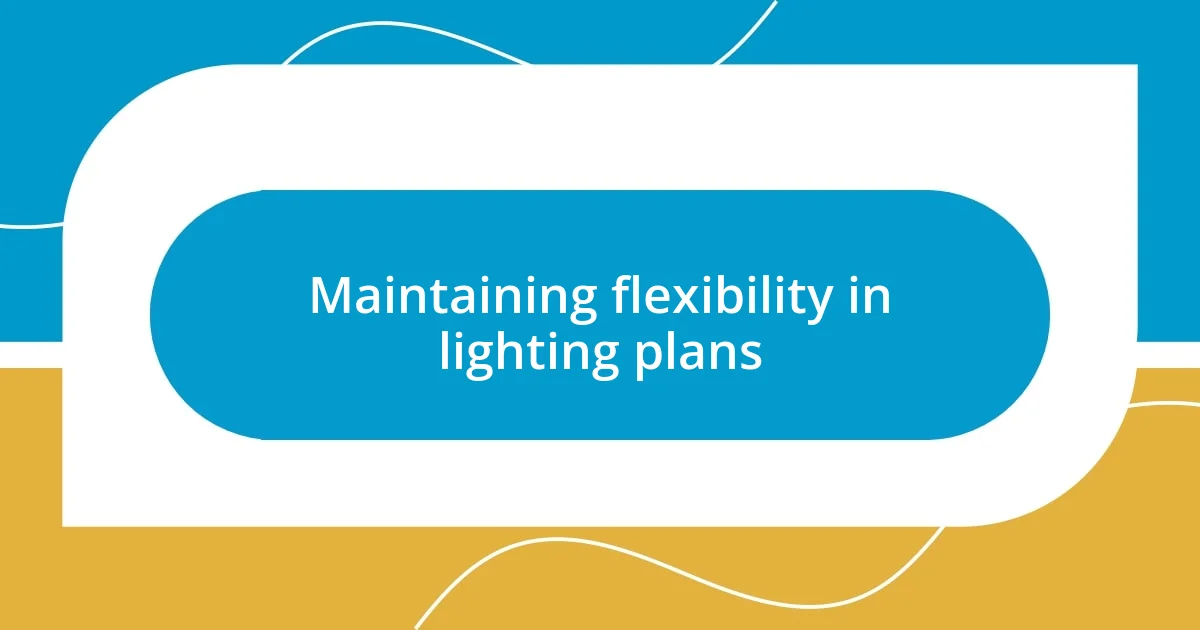
Maintaining flexibility in lighting plans
Flexibility in lighting plans is crucial for adapting to changing circumstances throughout the day. I’ve found that being open to rearranging my space according to natural light’s ebb and flow can significantly enhance my productivity. Once, on a particularly sunny afternoon, I shifted my desk to face the window, and the rush of daylight transformed my work mood dramatically—have you ever tried repositioning your workspace to capture sunlight in a different way?
There are times when unexpected weather alters my plans, and this requires a creative response. On one rainy day, instead of relying solely on artificial lights, I called upon my collection of reflective surfaces—mirrors and light-colored decorations—to brighten the space. This little tweak allowed me to harness the available light, turning the gloom into a cozy atmosphere. How do you adjust your approach when the weather doesn’t cooperate with your lighting plans?
Ultimately, I believe that having a dynamic mindset about lighting can lead to surprising discoveries. Sometimes, the best moments arise from an improvised setting. I remember the time a sudden storm darkened my room, prompting me to use candlelight in place of electric bulbs. That flickering warmth created an intimate ambiance, allowing for deep reflection while journaling. Isn’t it curious how often the unplanned can deliver the most memorable experiences?












